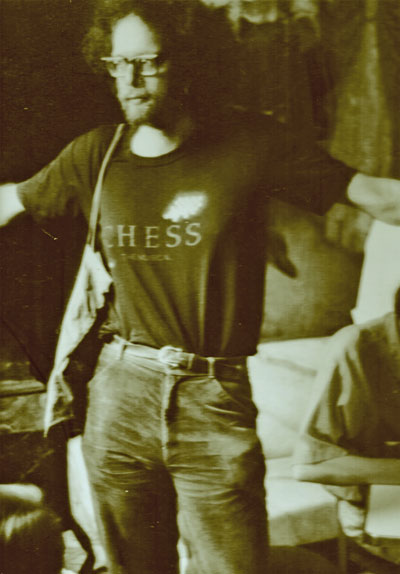Jon Speelman's Agony Column #22
At the Baku Olympiad, Genna Sosonko discovered that I was about to have a large round birthday and every time we bumped into each other he would put up three and later two fingers to remind me of the number of weeks till the fateful day.
I'm writing on October 1st, the day before the said event, and so I guess that this week the Agony (and possibly a soupcon of Ecstasy too) is mine. Accordingly, I'm going to show a couple of my own games from Lone Pine 1978. Way back then, international titles were much rarer and players developed much more slowly than today; and at the age of 21, I wasn't even an International Master, let alone a grandmaster.

Oldest picture available: me, a few years after the Lone Pine tournament
Lone Pine gave me my final IM norm and also in the first round – so late a developer was I – my first ever win against a grandmaster. This was Bent Larsen who in his defence was probably jet-lagged and in any case went on to win the tournament outright. I made about fifty percent but did get that norm.

Bent Larsen, middle, with Lone Pine sponsors Louis and Doris Statham in 1978
This game had already been annotated but I've cleaned it up and added some explanatory comments. The second below against Peter Biyiasas was more or less virgin territory.

[Event "Lone Pine op"] [Site "?"] [Date "1978.??.??"] [Round "1"] [White "Speelman, J."] [Black "Larsen, B."] [Result "1-0"] [ECO "A53"] [WhiteElo "2410"] [BlackElo "2620"] [Annotator "Speelman,Jonathan"] [PlyCount "71"] [EventDate "1978.??.??"] [SourceTitle "MCL 01"] 1. e4 c6 2. c4 {Presumably intending a Panov after} e5 (2... d5 3. exd5 cxd5 { and either} 4. d4 {or} (4. cxd5 {but Larsen naturally wanted a more strategically complicated battle and so went for something supposedly more confusing.})) 3. Nf3 d6 (3... Nf6 4. Nc3 Bb4 (4... Qa5 $6) 5. Nxe5 Qe7 6. Nd3 Nxe4 7. Qe2 Nxc3 8. dxc3 Qxe2+ 9. Bxe2 {is a clean position where White is somewhat better, so again precisely what Larsen didn't want.}) 4. d4 Bg4 5. Be2 (5. dxe5 $6 Bxf3 6. Qxf3 (6. gxf3 {is much more challenging but also clearly riskier than I wanted.}) 6... dxe5 {gives Black far too many black squares.}) 5... Nd7 6. Nc3 Be7 7. O-O Ngf6 8. Rb1 $5 {/\b4} (8. Be3) 8... O-O 9. Re1 Re8 10. Be3 {/\Nd2} Bh5 {Black intends to avoid the exchange of bishops after 11. Nd2. /\11...Ng4} 11. Nd2 Bg6 {[#]} (11... Bxe2 12. Qxe2 $14) 12. d5 $1 (12. f4 exf4 13. Bxf4 Bf8 14. Bf3 c5 $13 {and Black's pieces are working}) 12... a6 13. b4 h5 $5 {Larsen loved to push his rook's pawns and, so partly, perhaps as an homage to him, do I. Still this is slightly excessive.} 14. a4 h4 $6 {This makes quite a serious target.} 15. h3 Qc7 16. Rb3 {To defend Nc3.} a5 $5 (16... Rab8) 17. b5 cxd5 $6 (17... c5 {looks better to keep the queenside closed. I suspect that we both thought that} 18. Bg5 {is nasty intending} Nh7 $2 (18... Nb6 {however is okay because if} 19. Bxh4 Nxe4 20. Ncxe4 Bxh4 {Black is fine.}) 19. Bxe7 Rxe7 20. Nf3 $18) (17... cxb5) (17... Nc5 $5) 18. Nxd5 $1 Nxd5 19. cxd5 Rec8 $2 {[#]} 20. Bg4 $1 {Larsen had missed this move.} Rf8 (20... Nc5 $2 21. Bxc5 Qxc5 22. Bxc8 $18) 21. Qc1 Nc5 $6 {When playing a weaker opponent the stronger one must muddy the waters if things go wrong. Larsen therefore kept the queens on.} (21... Rac8 $2 22. Qxc7 $1 Rxc7 23. b6 $18) ({However} 21... Qxc1 22. Rxc1 Nc5 23. Bxc5 dxc5 {while vile might have given more chances.}) 22. Bxc5 dxc5 23. b6 {Of course it makes sense to make more of a mess of Black's queenside though} (23. Nc4 b6 {must also be tremendous.}) 23... Qd8 24. Nc4 { [#]} Bxe4 $6 {Again trying to make a mess but since he ends up with repulsive white squares it actually helped me.} 25. Rxe4 f5 26. Bxf5 $1 (26. d6 $1 Bg5 27. Qd1 fxe4 28. Qd5+ Kh8 29. Nxe5 $1 $18 {Seirawan (in ChessBase Magazine I imagine): was also totally winning.}) 26... Rxf5 27. d6 Bf6 {[#]} 28. Qd1 $1 { The white squares are now very definitely not Black's friends..} Qd7 29. Qg4 Rd8 (29... Qxa4 30. Ra3 Qd7 31. Ne3 $18) 30. Rb5 Qc8 31. Rxa5 Rf4 32. Qxc8 Rxc8 33. Rxf4 exf4 34. Ra7 Re8 (34... Rb8 35. a5 {/\36.Rb7 Rb7 37.a6}) 35. Rxb7 Kh7 {[#] /\Re1+,Bd4-f2-g3.} 36. Re7 $1 (36. Re7 Bxe7 37. dxe7 Rxe7 38. a5 $18 { White queens.}) 1-0

[Event "Lone Pine op"] [Site "?"] [Date "1978.??.??"] [Round "6"] [White "Speelman, J."] [Black "Biyiasas, P."] [Result "0-1"] [ECO "A42"] [WhiteElo "2410"] [BlackElo "2405"] [Annotator "Jon Speelman"] [PlyCount "57"] [EventDate "1978.??.??"] [SourceTitle "MCL 01"] 1. c4 g6 2. e4 d6 3. d4 e5 4. Nf3 Bg7 5. Nc3 Bg4 $6 {This forces White to make a decision in the centre, but after the obvious d5 the bishop is misplaced on g4. Instead the most common are} (5... Nc6 {and}) (5... exd4 6. Nxd4 Nc6) 6. d5 Nf6 7. h3 Bc8 8. Be3 {Two tempi ahead White has a marvellous position} O-O 9. Be2 {At first I couldn't see why I bothered with this when} (9. g4 {looks so appealing immediately. But presumably I was then worried about} h5 {which more or less forces} 10. Nh2) 9... Nbd7 10. g4 Nc5 11. Nd2 a5 12. h4 c6 (12... h5 { does need to be considered for a moment, but} 13. gxh5 Nxh5 14. Bxc5 dxc5 15. Bxh5 gxh5 16. Qxh5 Ra6 17. Rg1 Rg6 18. Ke2 {or} (18. O-O-O {are obviously much better for White.})) 13. h5 (13. g5) 13... Ne8 14. Nf1 cxd5 15. cxd5 gxh5 { I definitely hadn't seen this, the point being that if} 16. gxh5 (16. Rxh5 Nf6 17. Ng3 Nxh5 18. Nxh5 {and White has plenty for the exchange. But it's annoying that you've had to sacrifice at all}) (16. Bxc5 dxc5 17. Rxh5 { is also very much worth considering}) 16... Kh8 17. Rg1 Bf6 18. Qd2 Bd7 19. Bh6 Ng7 20. Qe3 Rg8 21. Qf3 Qe7 {(#) This is the critical position. White would like to exchange the white squared bishops to cement contorl of f5. But if I wait a move then Black will get the rook across to f8 and then answer Bb5 with Bc8. If I remember, I had quite a long think and convinced myself that the maximalist Bb5 was playable. I can't remember whether I saw Nf5 at all but if I did so I grossly underestimated it..} 22. Bb5 $2 (22. Ne3 Raf8 23. Bb5 Bc8 24. O-O-O {kept a nice safe advantage though Black can fight after} Bh4) 22... Nf5 $3 {Black jumps out and even if engines tell us that White can still defend, in practice he has every chance of being blown to smithereens.} 23. Rxg8+ Rxg8 24. exf5 (24. Bxd7 Nd4 25. Qh3 {would have at least avoided what happened in the game when after} Nc2+ (25... Nxd7 26. O-O-O b5 {is simple and strong for Black}) 26. Kd2 Nxa1 27. Bb5 Bg5+ 28. Bxg5 Qxg5+ 29. Ne3 {despite the loss of the exchange White is fighting since the position is intact and the knight trapped on a1 for the moment.}) 24... Bxb5 25. Nxb5 e4 26. Qe2 $2 ({ Houdini tells me that} 26. Qe3 {is actually still good for White after} Nd3+ 27. Ke2 {the point being that if} Qe5 (27... Rg2 28. Ng3 Rxf2+ 29. Qxf2 Nxf2 30. Rc1 $1) 28. Nd2 Qxb2 29. Nxd6 $1) 26... Nd3+ 27. Kd2 $2 (27. Kd1 Qe5 28. Nc3 Qd4 29. Qe3 {was still aparently unclear.}) 27... Qe5 28. Ke3 {(#)} Rg5 $1 29. a4 {I don't know whether I resigned or played this and then did so. In any case it's mate in 1. A reverse which was perhaps "shockingly quick" but shouldn't have been that unexpected after I pushed my luck with the maximalist Bb5. The fact that engines tell me that White is still better is irrelevant. If you can play simple and sensible moves to retain a pleasant advantage you should do so. Gambling in a total mess is something you can and should do if you're in trouble: not something you should precipitate when you're clearly better.} 0-1
Did you enjoy the column and instructive analysis by GM Jonathan Speelman? Do you wish you could have a world-renowned grandmaster analyzing your play? You can! Just send in two of your games: one success story (Ecstasy) and one loss (Agony). Tell why you chose them, where or when they were played, and if they are selected, not only will you get free detailed commentary of your games by one of chess’s great authors and instructors, and former world no. 4 player, but you also win a free one-month Premium subscription to ChessBase Account.

A one-month Premium subscription to ChessBase Account, means that for one month you get:
- Premium access to the Playchess server with ratings, simuls, lectures, and live commentary of top games.
- Access to all Web apps with no restrictions, such as the Cloud database (MyGames.chessbase.com), and more!
- Full access to the Video archive, which not only includes all the past lectures by Daniel King, Simon Williams and others, but also a large number of full ChessBase products you would normally need to buy in the ChessBase Shop, but that you can view for free as a Premium subscriber.



























